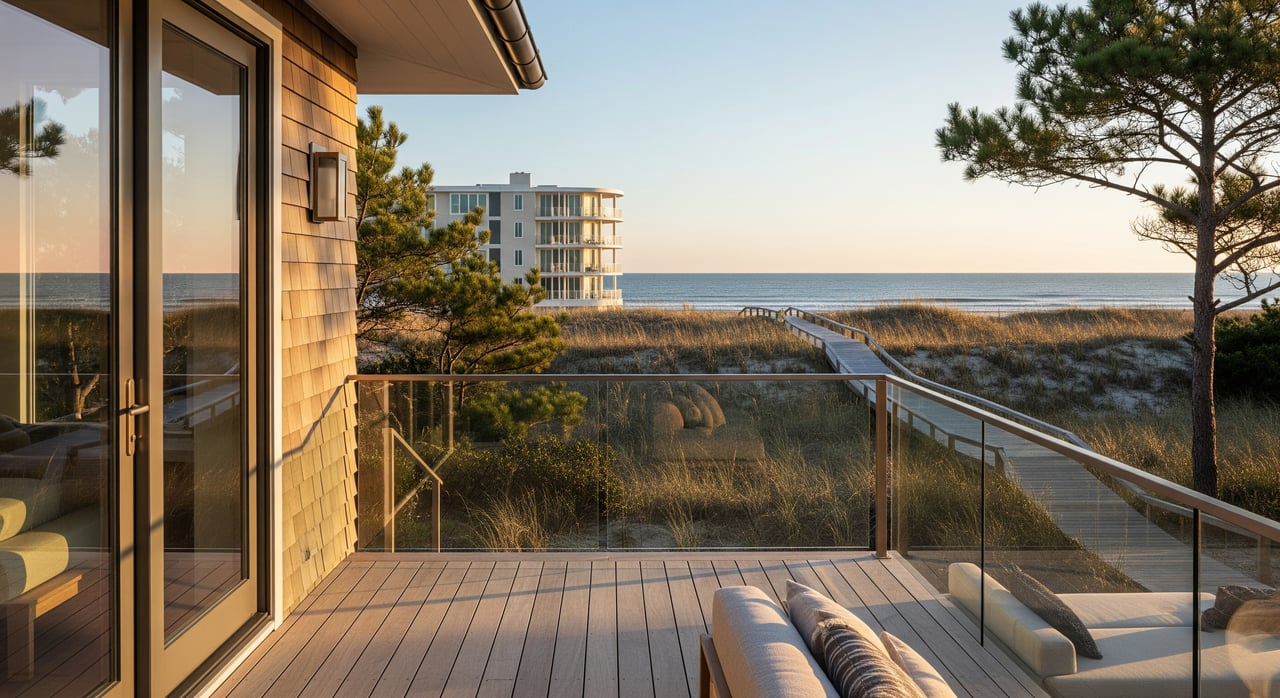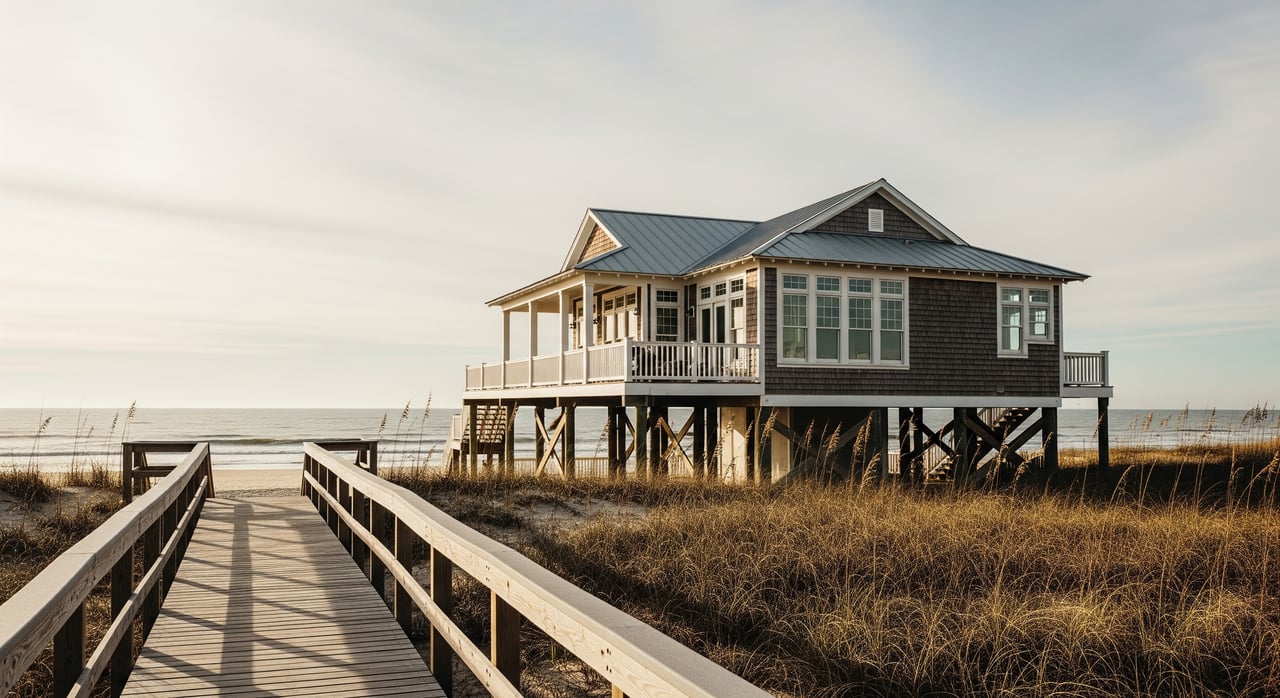Wilmington, NC, is a picturesque coastal city with scenic river views. For those considering a move to this delightful corner of North Carolina, Wilmington has a rich tapestry of architectural styles that tell the story of its past while highlighting its enduring charm. From grand antebellum mansions to elegant Victorian homes, the architecture in Wilmington is as diverse as it is beautiful, providing a unique backdrop for a lifestyle steeped in Southern elegance.
Wilmington's architectural history is a fascinating journey through time, reflecting the city's growth and prosperity over the centuries. The historic downtown area, with its cobblestone streets and tree-lined avenues, boasts some of the finest examples of 19th-century architecture. These structures, many of which have been meticulously preserved, offer a glimpse into the city's rich heritage, showcasing styles such as Greek Revival, Italianate, and Gothic Revival.
The city's blend of old-world charm and modern conveniences makes it an ideal place to call home, with everything from quaint historic cottages to Wilmington, NC luxury homes. The city's unique architectural landscape will undoubtedly capture your imagination as you explore the various neighborhoods.
Temple of Israel
1 S 4th St, Wilmington
The Temple of Israel, completed in 1876, is a significant piece of Wilmington's architectural and cultural heritage. As the oldest Jewish temple in North Carolina, it holds a special place in the city's history and the broader story of Jewish life in the American South. The temple is one of the earliest Reform synagogues established in this region, reflecting the time's diverse and evolving religious landscape.
Architecturally, the Temple of Israel is a striking example of the Romanesque Revival style, a design choice that sets it apart from other historic buildings in Wilmington. The structure is easily recognized by its rounded arches and distinctive dome, hallmarks of this architectural genre. One of the most remarkable aspects of the Temple of Israel is that it is one of only 30 Jewish congregations in the United States still worshiped in its original 19th-century structure.
The Temple of Israel, completed in 1876, is a significant piece of Wilmington's architectural and cultural heritage. As the oldest Jewish temple in North Carolina, it holds a special place in the city's history and the broader story of Jewish life in the American South. The temple is one of the earliest Reform synagogues established in this region, reflecting the time's diverse and evolving religious landscape.
Architecturally, the Temple of Israel is a striking example of the Romanesque Revival style, a design choice that sets it apart from other historic buildings in Wilmington. The structure is easily recognized by its rounded arches and distinctive dome, hallmarks of this architectural genre. One of the most remarkable aspects of the Temple of Israel is that it is one of only 30 Jewish congregations in the United States still worshiped in its original 19th-century structure.
Bellamy Mansion Museum
503 Market St, Wilmington
The Bellamy Mansion Museum, built in the 1850s, is one of Wilmington's most iconic architectural landmarks. The 10,000-square-foot mansion, with its impressive 22 rooms, exemplifies the grandeur of the pre-Civil War South. Designed in a blend of Greek Revival and Italianate styles, the mansion's architectural features, including its towering 25-foot Corinthian columns, make it a standout example of 19th-century Southern architecture.
The mansion now operates as a museum, offering visitors an in-depth look at life in Wilmington during the antebellum period. One of the most historically significant aspects of the property is the original two-story brick slave quarters located on the northeast corner of the lot. The plainly finished building, one room deep and three rooms wide, typifies the urban slave quarters of the late antebellum South. Unlike the small, crude huts associated with rural plantations, this structure's windowless back wall and functional design reflect the realities of urban slavery in that era.
While such buildings were once common in cities where slavery was legal, they are now rare, making this site an important piece of historical architecture. The Bellamy Mansion Museum serves as a powerful reminder of Wilmington's complex history, preserving the grandeur and stark contrasts of its past.
The Bellamy Mansion Museum, built in the 1850s, is one of Wilmington's most iconic architectural landmarks. The 10,000-square-foot mansion, with its impressive 22 rooms, exemplifies the grandeur of the pre-Civil War South. Designed in a blend of Greek Revival and Italianate styles, the mansion's architectural features, including its towering 25-foot Corinthian columns, make it a standout example of 19th-century Southern architecture.
The mansion now operates as a museum, offering visitors an in-depth look at life in Wilmington during the antebellum period. One of the most historically significant aspects of the property is the original two-story brick slave quarters located on the northeast corner of the lot. The plainly finished building, one room deep and three rooms wide, typifies the urban slave quarters of the late antebellum South. Unlike the small, crude huts associated with rural plantations, this structure's windowless back wall and functional design reflect the realities of urban slavery in that era.
While such buildings were once common in cities where slavery was legal, they are now rare, making this site an important piece of historical architecture. The Bellamy Mansion Museum serves as a powerful reminder of Wilmington's complex history, preserving the grandeur and stark contrasts of its past.
Thalian Hall
310 Chestnut St, Wilmington
Thalian Hall, completed in 1858, is one of the oldest theaters in continuous use in the United States. The two-story, five-bay stuccoed brick building is significant to Wilmington's cultural and architectural history. Thalian Hall's design merges Greek Revival architectural elements with a grand, opulent interior, making it a beloved venue for performances for over a century.
The building's exterior, characterized by its symmetrical façade and classical detailing, reflects the Greek Revival style popular during the mid-19th century. Inside, the theater offers an impressive auditorium that has been carefully preserved and restored over the years. The space is adorned with ornate decorations, capturing the grandeur of a bygone era while continuing to serve as a vibrant cultural hub for the community. Thalian Hall is an enduring part of Wilmington's arts scene, hosting everything from plays and concerts to films and lectures.
Thalian Hall, completed in 1858, is one of the oldest theaters in continuous use in the United States. The two-story, five-bay stuccoed brick building is significant to Wilmington's cultural and architectural history. Thalian Hall's design merges Greek Revival architectural elements with a grand, opulent interior, making it a beloved venue for performances for over a century.
The building's exterior, characterized by its symmetrical façade and classical detailing, reflects the Greek Revival style popular during the mid-19th century. Inside, the theater offers an impressive auditorium that has been carefully preserved and restored over the years. The space is adorned with ornate decorations, capturing the grandeur of a bygone era while continuing to serve as a vibrant cultural hub for the community. Thalian Hall is an enduring part of Wilmington's arts scene, hosting everything from plays and concerts to films and lectures.
Burgwin-Wright House and Gardens
224 Market St, Wilmington
The Burgwin-Wright House, built in 1770 for John Burgwin, a prominent merchant, planter, and government official, is one of Wilmington's oldest and most historically significant structures. This Georgian-style house, characterized by its elegant symmetry and classic colonial design, is a testament to the architectural traditions of the 18th century. It is also the only remaining structure from Wilmington's colonial era open to the public, offering a rare glimpse into the city's early history.
The Burgwin-Wright House is now a museum with 18th and 19th-century antiques, providing an authentic look at the period's interior design. Each room showcases hundreds of objects that reflect the lifestyle and tastes of the era, making it a rich educational resource for visitors. The museum provides context to those who lived and worked there.
In addition to its historic interiors, the property features beautifully maintained gardens that complement the house's colonial architecture. These gardens, which are also open to the public, offer a peaceful retreat in the heart of downtown Wilmington, making the Burgwin-Wright House a unique cultural landmark.
The Burgwin-Wright House, built in 1770 for John Burgwin, a prominent merchant, planter, and government official, is one of Wilmington's oldest and most historically significant structures. This Georgian-style house, characterized by its elegant symmetry and classic colonial design, is a testament to the architectural traditions of the 18th century. It is also the only remaining structure from Wilmington's colonial era open to the public, offering a rare glimpse into the city's early history.
The Burgwin-Wright House is now a museum with 18th and 19th-century antiques, providing an authentic look at the period's interior design. Each room showcases hundreds of objects that reflect the lifestyle and tastes of the era, making it a rich educational resource for visitors. The museum provides context to those who lived and worked there.
In addition to its historic interiors, the property features beautifully maintained gardens that complement the house's colonial architecture. These gardens, which are also open to the public, offer a peaceful retreat in the heart of downtown Wilmington, making the Burgwin-Wright House a unique cultural landmark.
Latimer House Museum
126 S 3rd St, Wilmington
The Latimer House Museum, built in 1852, is an iconic example of Victorian Italianate architecture. The historic home's distinctive design and intricate details are key to the city's architectural heritage. The Latimer House is well preserved, offering a window into the Victorian era, not only through its architecture but also through the furnishings and decor that fill its rooms.
As a museum, the Latimer House provides visitors with a comprehensive look at the lifestyle and history of the families who lived there during the 19th century. The estate is filled with period-specific antiques that bring the Victorian era to life, offering a tangible connection to Wilmington's past. In addition to its richly furnished interiors, the Latimer House boasts beautifully maintained gardens, adding to the estate's historic charm.
The Latimer House Museum, built in 1852, is an iconic example of Victorian Italianate architecture. The historic home's distinctive design and intricate details are key to the city's architectural heritage. The Latimer House is well preserved, offering a window into the Victorian era, not only through its architecture but also through the furnishings and decor that fill its rooms.
As a museum, the Latimer House provides visitors with a comprehensive look at the lifestyle and history of the families who lived there during the 19th century. The estate is filled with period-specific antiques that bring the Victorian era to life, offering a tangible connection to Wilmington's past. In addition to its richly furnished interiors, the Latimer House boasts beautifully maintained gardens, adding to the estate's historic charm.
St. James Episcopal Church
25 S 3rd St, Wilmington
Founded in 1729, St. James Episcopal Church is Wilmington's oldest church and one of the oldest continually active congregations in North Carolina. The current church building, completed in 1839, is a prime example of Gothic Revival architecture, characterized by its pointed arches, intricate tracery, and vertical emphasis. This architectural approach gives the church its distinct and timeless appearance, making it a significant landmark in Wilmington.
One of the most striking features of St. James Episcopal Church is its beautiful stained glass windows, which add both color and light to the sanctuary. These windows and the church's other architectural details contribute to an atmosphere of reverence and history. The church also features a historic cemetery on its grounds, a resting place for many of Wilmington's early residents, further connecting the site to the city's past.
Founded in 1729, St. James Episcopal Church is Wilmington's oldest church and one of the oldest continually active congregations in North Carolina. The current church building, completed in 1839, is a prime example of Gothic Revival architecture, characterized by its pointed arches, intricate tracery, and vertical emphasis. This architectural approach gives the church its distinct and timeless appearance, making it a significant landmark in Wilmington.
One of the most striking features of St. James Episcopal Church is its beautiful stained glass windows, which add both color and light to the sanctuary. These windows and the church's other architectural details contribute to an atmosphere of reverence and history. The church also features a historic cemetery on its grounds, a resting place for many of Wilmington's early residents, further connecting the site to the city's past.
Embracing Wilmington's timeless charm
Wilmington's rich architectural heritage, from the colonial-era Burgwin-Wright House to the Gothic Revival beauty of St. James Episcopal Church, makes it a unique place to call home. For those considering a move to this charming city, the Sherwood Strickland Group is ready to help you find the perfect neighborhood to match your lifestyle. As global real estate agents, they have the expertise and local knowledge to guide you through Wilmington's diverse real estate landscape, ensuring you find a home that meets all your needs. With their help, you can embrace the timeless charm of Wilmington while finding a place that feels just right for you.




